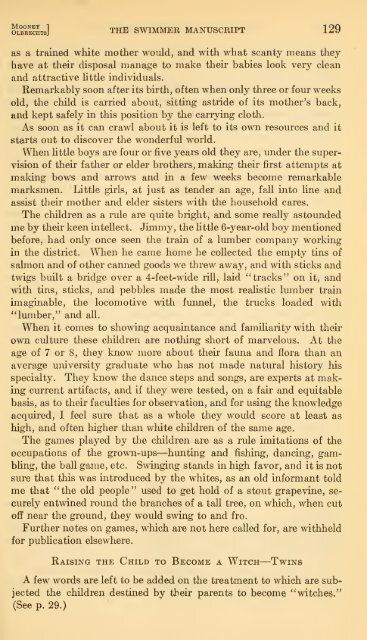Untitled - Smithsonian Institution
Untitled - Smithsonian Institution
Untitled - Smithsonian Institution
You also want an ePaper? Increase the reach of your titles
YUMPU automatically turns print PDFs into web optimized ePapers that Google loves.
Olbrechts] the swimmer MANUSCRIPT 129<br />
as a trained white mother would, and with what scanty means they<br />
have at their disposal manage to make their babies look very clean<br />
and attractive little individuals.<br />
Remarkably soon after its birth, often when only three or four weeks<br />
old, the child is carried about, sitting astride of its mother's back,<br />
and kept safely in this position by the carrying cloth.<br />
As soon as it can crawl about it is left to its own resources and it<br />
starts out to discover the wonderful world.<br />
When little boys are four or five years old they are, under the super-<br />
vision of their father or elder brothers, making their first attempts at<br />
making bows and arrows and in a few weeks become remarkable<br />
marksmen. Little girls, at just as tender an age, fall into line and<br />
assist their mother and elder sisters with the household cares.<br />
The children as a rule are quite bright, and some really astounded<br />
me by their keen intellect. Jimmy, the little 6-year-old boy mentioned<br />
before, had only once seen the train of a lumber company working<br />
in the district. When he came home he collected the empty tins of<br />
salmon and of other canned goods we threw away, and with sticks and<br />
twigs built a bridge over a 4-feet-wide rill, laid "tracks" on it, and<br />
with tins, sticks, and pebbles made the most realistic lumber train<br />
imaginable, the locomotive with funnel, the trucks loaded with<br />
"lumber," and all.<br />
When it comes to showing acquaintance and familiarity with their<br />
own culture these children are nothing short of marvelous. At the<br />
age of 7 or 8, they know more about their fauna and flora than an<br />
average university graduate who has not made natural history his<br />
specialty. They know the dance steps and songs, are experts at mak-<br />
ing current artifacts, and if they were tested, on a fair and equitable<br />
basis, as to their faculties for observation, and for using the knowledge<br />
acquired, I feel sure that as a whole they would score at least as<br />
high, and often higher than white children of the same age.<br />
The games played by the children are as a rule imitations of the<br />
occupations of the grown-ups—hunting and fishing, dancing, gambling,<br />
the ball game, etc. Swinging stands in high favor, and it is not<br />
sure that this was introduced by the whites, as an old informant told<br />
me that "the old people" used to get hold of a stout grapevine, securely<br />
entwined round the branches of a tall tree, on which, when cut<br />
off near the ground, they would swing to and fro.<br />
Further notes on games, which are not here called for, are withheld<br />
for publication elsewhere.<br />
Raising the Child to Become a Witch— Twins<br />
A few words are left to be added on the treatment to which are sub-<br />
jected the children destined by their parents to become "witches,"<br />
(See p. 29.)

















